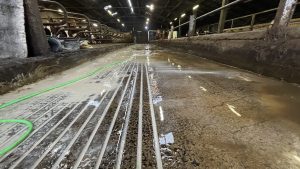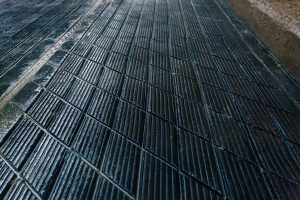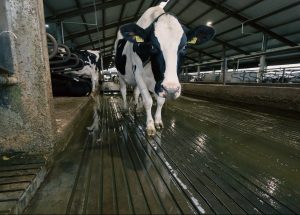Interview with Karl Burgi, founder of Trakrite global; published in SAIMNIEKS magazine, APR 2023
Properly grooved farm floors contribute to the daily comfort and mobility of dairy cows when moving through the aisles, reduce the risk of injuries, hoof wear and damage caused by them. Trakrite Global fermu grīdu rievošanas metodes ir pārbaudījuši un atzinīgi novērtējuši govju fermu īpašnieki Ziemeļamerikā, Okeānijā un Eiropā. Karls Burgi, Trakrite Global dibinātājs un zinošs eksperts šajā jomā, stāsta par unikālo grīdu rievošanas tehnoloģiju un tās nozīmi govju nagu veselībā.
– Please introduce yourself
– I was born and raised in Switzerland, but 43 years ago I moved to the United States (USA) for further education. I worked as a herd manager for 10 years and started trimming hoof myself in several farms. In 1989, I decided to make hoof cutting my profession. At that time, there were many small farms in the US with 50-80 cows and only a few farms with 150-180 cows. As time went on, I realized that I needed to gain in-depth knowledge of cow hoof cutting and health, so in 1995 I attended a hoof cutting course in the Netherlands. I gained a much better understanding of the subject and as a result I started a nail cutting school here in the USA called Dairyland Hoof Care Institute. 28 gadu laikā šajā institūtā ir apmācīts vairāk nekā 5000 cilvēku no 45 pasaules valstīm. Pagājušā gada jūnijā es vadīju apmācības arī vienā no lielākajām piena lopu saimniecībām Latvijā – Agrofirma Tērvete.
In 1998, I began consulting on hoof health for farms around the world. I have been to farms in the Middle East, Australia, Japan, all over North America and Europe and I learn something every time I visit a farm. The main conclusion - if there is a problem, it always has a cause and a solution.
We have learned more and more about why dairy cows develop lameness. The average lameness rate worldwide is 25%, but there is a reason why some farms have lameness in 3% of cows and in others 15% to 30% of the herd. In collaboration with the University of Wisconsin and other researchers from around the world, I am trying to understand the reasons. Today, using the knowledge gained and working properly, it is very realistic to have lameness at or below 5% on our dairy farms, but to achieve this requires commitment from farm management. The most common factor affecting lameness is the comfort of the cows - stalls or untied beds, floors and general management have a huge impact. Cow comfort is a priority. We need to make sure that the cows are not standing for too long, that the heat reduction system is working properly and that the cows can walk on suitable floors.
– What are the most common mistakes you've seen while visiting farms around the world?
– In my experience, a lot of problems on farms are caused by over-cutting hoofs because the workers don't understand their anatomy. Many times when teaching proper hoof trimming, I first make sure students understand the anatomy to avoid over-trimming.
There are 2 main hoof diseases – sole ulcer and white line lesion. Thanks to research carried out over the last 7 years, we have managed to significantly reduce the prevalence of both diseases. Today it is very realistic to reduce the incidence of sole ulcers in cows from 10% to 2% in the herd. Of course, it's not just a matter of hoof clipping, but research shows that when hoof clipping is done right, the effects are significant.
Sole ulcers and white line lesions can both be related to farm flooring. For example, if the floors are slippery, the cow's hooves experience more impact, which causes certain types of injuries, promotes increased keratinization and causes lameness. Again, thanks to new research, we have been able to eliminate a lot of this. In addition, by creating a floor covering with adequate traction, we reduce the risk of lameness.
In my opinion, rubber mats are not the best surface for farm floors. If the untethered stalls are not comfortable, but we put rubber on the floor, the cows are too comfortable to stand and will not sleep. Research shows that if cows sleep for about 12 to 13 hours out of a 24 hour period, the risk of hoof damage is significantly reduced. If cows sleep less than 12 h, the risk increases.
Rubber flooring can be laid when cows have to walk a long distance and normal hoof growth cannot compensate for wear and tear from abrasive floors. The other place I would recommend rubber flooring is at 90 degree turns such as when exiting the parlour, onto the decks of the parlour, or at the front of the holding area before the parlour. These are the places to put the rubber because that is where the cows experience extra pressure on the hooves, which we want to avoid.
If we look at the records from the farms, we see that all over Europe, from August to October, cows have a higher number of sole ulcers. The reason is due to the effects of the heat characteristic of June, July and August. When cows are hot, they don't sleep. They will not reach the 12 hour sleep goal unless we have good ventilation and a good heat reduction system.
– How were they created the Trakrite Global solutions for floor grooving?
– In 2001 I visited a farm and was amazed at how well the cows moved across the floor. There was not much sand in the sleeping areas, as was common in the US and other parts of the world at the time. The sand gives the floor additional grip, which makes the cows move more safely on the floor. Even on a poorly grooved floor with sand on it, cows will not slip. I examined the farm floors and found that they have 1.9 cm wide grooves with a 6.3 to 6.5 cm gap. While building the facility, they had imprinted this pattern on the floor in the wet concrete. When I got home, I talked to one of my colleagues at the University of Wisconsin in Madison and showed him what I had found.
In further research, we found that with the mentioned dimensions (1.9 cm wide grooves with a gap of 6.3 to 6.5 mm), one of the nails always rests on the groove and the nail gets a better grip because the groove is 1.8–1.9 cm wide. A normal hoof is just over 5 cm wide, so 1/3 of the hoof rests on this wide groove and gives enough grip for stability.
That is how Deep-Groove ® model was developed. Now this solution is offered by Trakrite Global – a company that produces a special machine so that this grooving can also be obtained in hardened concrete.
I believe that a floor in a dairy farm can be compared to a floor in a factory - it should be good enough to last a long time, but also safe enough to guarantee the safety of the cows. If we build farm floors right from the start, they will last longer.
After several years, we noticed that in many older farms, the concrete had become polished and slippery due to constant cleaning of the floors. For this reason, a friend and I created a machine that cut grooves into existing concrete floors. We used this technology on many old farms and received good feedback from the owners. If the building is more than 20 years old, in some cases one type of grooving may not be ideal. That's why we developed 3 different methods, also suitable for old floors, - leveling the surface (planing), Deep-Groove ® surfaces and Mini-Groove ® surface creation. On a Swiss farm where there were no deep grooves before, they were created and a study was conducted by filming cows on the farm 24 h before and after the improvements were made. What they observed was an increase in stride length of 20 cm after the deep grooves were created.
In 2006, I worked with a large farm in Australia with about 7,000 cows. They decided to build a new facility and cut all the deep grooves into the hardened concrete instead of driving them into the wet concrete. The grooves were cut 5 to 7 days after the concrete was poured. Even today, this farm has a very low sole ulcer rate - less than 2.5% in the last 4 years. This is achieved by the deep grooves combined with excellent cow comfort and ventilation.
With the knowledge I have now, if I were to build a new farm, I would cut the deep grooves after the concrete floor is poured and hardened. This provides a much smoother surface with better grip. It is important to pour the concrete correctly and wait for it to harden completely, then cut the grooves after 5 to 7 days. Trakrite Global technology has evolved over the years to adapt to the needs of modern dairy farms.
– Is there anything else a farmer should consider when choosing a grooving solution for their farm?
– First, you need to make sure that the best possible concrete mix and concrete floor is selected. Second, research must be done to ensure that the correct groove pattern will be used. We have evidence that good grooving can increase stride length, improve cows' sense of security when walking and reduce injuries.
Third, the situation must be monitored to determine whether there are problematic slippery areas in the barn, and if they are found, they must be addressed with the help of a specialist in the field.
It is important to make the grooves in the direction of the main movement, because cows need safety when they walk. I have observed over the years that wherever the farm has cross grooves, diagonal grooves or diamond grooves and cleaning is done in the direction of the main movement, there is a greater risk of infectious disease. This is because when we clean the barn in the same direction as the grooves, we also clean the manure that is in the grooves. If the grooves are transverse or diagonal, this is not possible, resulting in a higher concentration of bacteria in the grooves.
From a construction point of view, the main priority is to build the best possible untethered housing so that the cows can sleep 12 hours a day. We have good research that shows that if cows don't lie down, they produce less milk.
– Trakrite Global is a parto from brand Save Cows®. What is the purpose of this collaboration?
– The company that started our network of companies was Comfort Hoof Care. We established a cow hoof trimming equipment in 1989 and I provided hoof trimming services. Over time I learned more and more about cutting hooves and we continued to improve our equipment. I realized that I couldn't do the job at the highest level without the right tools.
 Soon after we established Dairyland Hoof Care Institute, where we teach proper hoof cutting techniques. Later we created Sure Step Consulting, to provide consulting services to dairy producers worldwide. We wanted to create a brand that reflected the purpose of all of our businesses. This brand is Save Cows® .
Soon after we established Dairyland Hoof Care Institute, where we teach proper hoof cutting techniques. Later we created Sure Step Consulting, to provide consulting services to dairy producers worldwide. We wanted to create a brand that reflected the purpose of all of our businesses. This brand is Save Cows® .
Trakrite Global was added to our network in 2015. Our manufacturing company is Synergy Metalworks, which manufactures all equipment Comfort Hoof Care and Trakrite Global needs
Save Cows® focuses on animal welfare. By providing proper hoof trimming, training people and offering solutions to hoof care problems, we save cows by extending their longevity on the farm.
With proper hoof trimming, grooved floors, favorable living conditions and herd management, cows now live up to 8 lactations with high productivity.
– Would you like to end this conversation with a wish for farmers?
– Farmers need to understand that lameness and injuries have origins. If we study these causes, we will find a solution. Sometimes floors need to be improved, sometimes cow housing or management practices. If you do all the things we discussed above, you will have a productive and profitable herd.
In addition, I would like to mention that Attor is the only floor grooving service provider in the Baltics in accordance with Trakrite Global methods and is able to help dairy producers provide the necessary flooring solutions.



